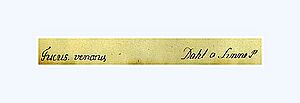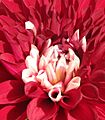Anders Dahl facts for kids
Quick facts for kids
Anders Dahl
|
|
|---|---|
| Born | 17 March 1751 Varnhem, Västergötland, Sweden
|
| Died | 25 May 1789 (aged 38) |
| Other names | Andreas Dahl |
| Education | Uppsala University |
| Known for | Observationes botanicae circa systema vegetabilium divi a Linne Gottingae 1784 editum, quibus accedit justae in manes Linneanos pietatis specimen |
| Parent(s) | Christoffer Dahl and Johanna Helena Enegren |
| Scientific career | |
| Fields | Botany |
| Institutions | Royal Academy of Åbo |
| Author abbrev. (botany) | Dahl |
Anders (or Andreas) Dahl was a Swedish scientist who loved plants. He was born on March 17, 1751, and became a student of the famous botanist Carl Linnaeus. You might know his name because the beautiful dahlia flower is named after him! Anders Dahl passed away on May 25, 1789, when he was 38 years old.
Contents
Anders Dahl's Early Life and Schooling
Anders Dahl was born in Varnhem, Sweden. His father, Christoffer Dahl, was a preacher. Anders showed a love for plants from a very young age.
When he was nine, another botanist named Anders Tidström met him. Tidström noticed Anders's interest in plants. He also saw Anders's collection of plants, which he got from his uncle.
In 1761, Anders started school in Skara. He found several friends who also loved nature and science. Together, they started a group called "The Swedish Topographic Society in Skara." This group studied plants, animals, geography, and history. Anders wrote many essays for the group.
On April 3, 1770, Anders went to Uppsala University. There, he became one of the students of Carl Linnaeus. Linnaeus was a very famous botanist. Sadly, Anders's father died in 1771. This meant Anders's family had money problems. He had to leave school early and could not finish his full education.
Anders Dahl's Work as a Naturalist
Carl Linnaeus recommended Anders for a job. Anders became a curator at a private museum and botanical garden. This garden belonged to Clas Alströmer, who was also a student of Linnaeus.
Anders's job meant he traveled a lot. He went on trips in Sweden and other countries. On these trips, he collected plants and other natural items. He collected them for Alströmer and for himself.
During this time, Anders got to study Linnaeus's own plant collection. This collection is now at the Swedish Museum of Natural History in Stockholm.
In 1781, Alströmer helped Linnaeus's son, Carl Linnaeus the Younger, travel to England. When the younger Linnaeus died, his father sent Alströmer a special collection of plants. Anders carefully listed every plant in this collection. He wrote down if the plant came from Linnaeus the father or Linnaeus the son. Anders also received some plants for his own collection.
In 1785, Alströmer faced financial problems. He moved to his estate, and Anders went with him.
In 1786, Anders received an honorary doctorate degree. This was from the University of Kiel in Germany. The next year, he became a professor at the Academy of Åbo in Turku, Finland. He taught medicine and botany there. He brought his own plant collection to Turku. Sadly, this collection was destroyed in a big fire in 1827. However, some parts of his collections are still kept in other museums today.
Anders Dahl died in Turku in 1789. He was only 38 years old.
Why the Dahlia Flower is Named After Him

The beautiful dahlia flower is named after Anders Dahl. Many people used to think Linnaeus named it. But Linnaeus died in 1778, and the dahlia flower was brought to Europe later.
It is most likely that Antonio Jose Cavanilles named the flower. He was the director of the Royal Gardens of Madrid. He received the first dahlia plants from Mexico in 1791. This was two years after Anders Dahl had passed away.
Anders was also honored in other ways. In the 1780s, his friend Carl Peter Thunberg named a plant after him. This plant was called Dahlia crinita. The name crinita means "longhaired" in Latin. It probably referred to Anders's large beard. This plant is now known as Trichocladus crinitus. Thunberg's original plant specimen is at the Swedish Museum of Natural History.
In 1994, another plant genus was named after him. It was called Dahliaphyllum.
Images for kids
See also
 In Spanish: Anders Dahl para niños
In Spanish: Anders Dahl para niños



